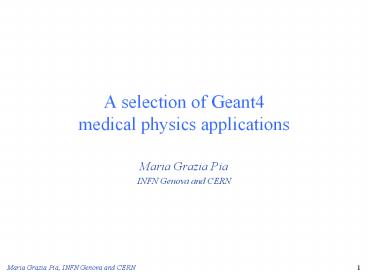A selection of Geant4 medical physics applications - PowerPoint PPT Presentation
1 / 13
Title:
A selection of Geant4 medical physics applications
Description:
medical physics applications Maria Grazia Pia INFN Genova and CERN The Magic Cube (INFN Torino) Sandwich of 12 parallel plate (25x25) cm2 ionization chambers Each ... – PowerPoint PPT presentation
Number of Views:146
Avg rating:3.0/5.0
Title: A selection of Geant4 medical physics applications
1
A selection of Geant4 medical physics
applications
- Maria Grazia Pia
- INFN Genova and CERN
2
The Magic Cube (INFN Torino)
Verification of the beam system to compare the
prescribed and delivered 3D dose distribution
- Sandwich of 12 parallel plate (25x25) cm2
ionization chambers - Each chamber
- passive material (N2,G10,Mylar)
- anode (0.035 mm Cu)
- active material (3 mm N2)
- passive material
- air gap (2 cm, tissue equivalent of adjustable
thickness) - Thickness of a chamber as water equivalent 1.1
mm
Between the two chambers and the remaining ten
ones there is room to insert a plastic absorber
(thickness to choose to match the depth through
the proximal edge of the SOBP)
3
A chamber of the Magic Cube
- Air 6 mm
- Mylar 0.05 mm
- N2 3 mm
- G10 0.1 mm
- Cu (cathode) 0.035 m
- N2 3 mm (active)
- Cu (anode) 0.035 mm
- G10 0.1 mm
- N2 6 mm
- Mylar 0.05 mm
- Air 6 mm
- Air 20 mm
4
Tests with theMagic Cube
- Test at GSI (Carbon beam)
- linearity better than 1
- uniformity better than 3
- position and width precision of about 1 mm
- Test at PSI (proton beam)
- Protons beam of 137 MeV
- Cube rotated by 180o
- No absorbers inside the Cube
- Range shifter of water in front of the Cube
- Test at CPO Orsay (p beam)
5
Bragg peak, Magic cube data and Geant4
Experimental data Bragg peak of a 270 MeV/u
carbon ion beam
distance(cm)
Geant4 and experimental data, PSI test with
proton beam
6
Brachytherapy (National Inst. Cancer Research,
Genova)
- Application of Geant4 to the verification of a
brachytherapy calibration procedure - Calibration of the radionuclide source strength
is an essential part of any brachytherapy QA
programme - MicroSelectron High Dose Rate (HDR) system at
Nat. Inst. Cancer Research - The MicroSelectron Ir-192 sources are supplied by
Mallinckrodt Medical B. V. - Holland with a
calibration certificate specifying the Air Kerma
Rate measure at a distance of 1 m with an
uncertainty of ? 5 - To verify the procedure to calibrate each new
MicroSelectron HDR brachytherapy source Geant4
is used to obtain simulated source Air Kerma
Rate at distance of 1 m and simulated isodose
distribution for the calculation of anisotropy
coefficients for unshielded and shielded vaginal
treatments - Geant4 Low Energy electromagnetic physics
processes - Geant4 Radioactive Decay Module
7
Brachyterapy at Nat. Inst. Cancer Research, Genova
S. Agostinelli, R. Corvo, F. Foppiano, S.
Garelli, G. Sanguineti
- The source holder is a standard endobronchial
treatment catheter, the chamber is a 0.6 cc
Capintec chamber connected to a Capintec 192
electrometer - The IST group follows the direction of Basic
Dosimetry on Radiotherapy with Brachytherapy
Source of the Italian Association of Biomedical
Physics (AIFB)
The custom calibration plexiglas jig, used for in
air measurements.
8
Treatment planning with Geant
Geant interfaced to a file obtained with a
Computer Tomography (CT) scan
Reconstruction of the optical nerves (black
pixels)
Reconstruction of the lung contour (black
pixels)
CT slice of a head with the dose deposition of a
proton beam obtained with the GEANT code
9
CT interface and treatment planning
- Two possible approaches
- CT interface Geant4 full simulation
- CT interface Geant4 fast simulation
(physics processes parameterised
through an analytical treatment) - Geant-based tools for
- inverse planning
- technique of active dose delivery
- Software interface for Geant4 that reads input
data in DICOM3 format developed at Medical Dept.,
University of Piemonte Orientale and INFN Torino
10
Geant4 for scatter compensation in Megavoltage 3D
CT
- Use GEANT4 to obtain digitally reconstructed
radiographs (DRRs), including full scatter
simulation - This represents a great improvement over
approaches based on ray-casting.
11
Use of Geant4 for scatter compensation in
Megavoltage 3D CT
- The study of DRRs synthesized by Geant4 allows
users to produce a model for scatter compensation
of megavoltage radiographs - This will help to produce a more accurate
megavoltage 3D CT reconstruction and therefore a
more reliable tool for patient positioning and
treatment verification - Activity in progress at the Italian National
Institute for Cancer Research, Genova - Other possible areas of application of Geant4
- LINAC head simulation
- Scatter analysis in total body irradiation
12
In vivo dosimetry for mammography
- TLD characterization for mammography screening
- simulation of dose deposition and glow curve
- Mammography simulation
- Goal minimize dose on patient
- Comparison between experimental data TLD in vivo
dosimetry and Geant4 simulation - Activity at Medical Physics Dept., Umberto I
Hospital of Ordine Mauriziano, Torino - in progress
13
Acknowledgments
- Many Geant4 collaborators and users have
contributed to this talk - S. Agostinelli, F. Foppiano, S. Garelli (Nat.
Inst. for Cancer Research) - R. Gotta (TERA)
- F. Bourhaleb, S. Chauvie, G. Nicco (INFN and
Univ. Torino) - V. Rolando (University of Piemonte Orientale)
- P. Nieminen (ESA)































